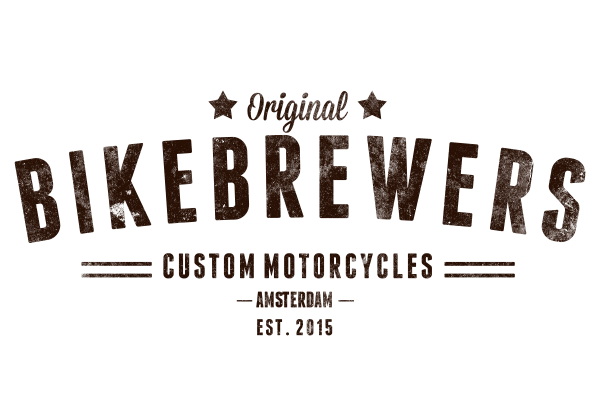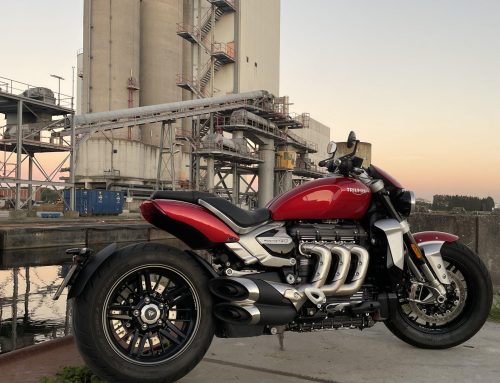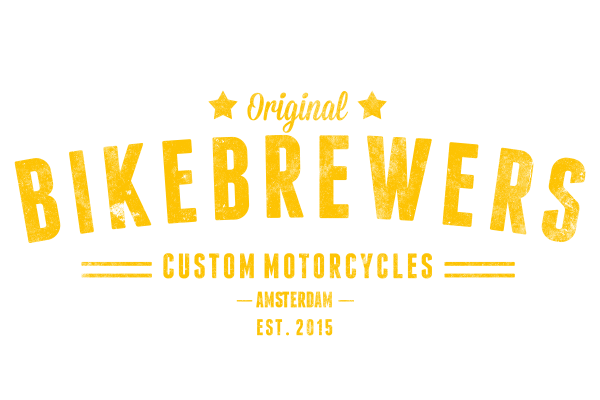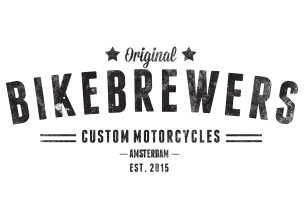Out of the silence, a screeching sound and a sudden wobble wake me up in an uninviting way – the train is reaching its next station. I’m on my way to Munich, where the all new Indian Scout will be revealed, the second iteration of the model that revived the long gone legend.
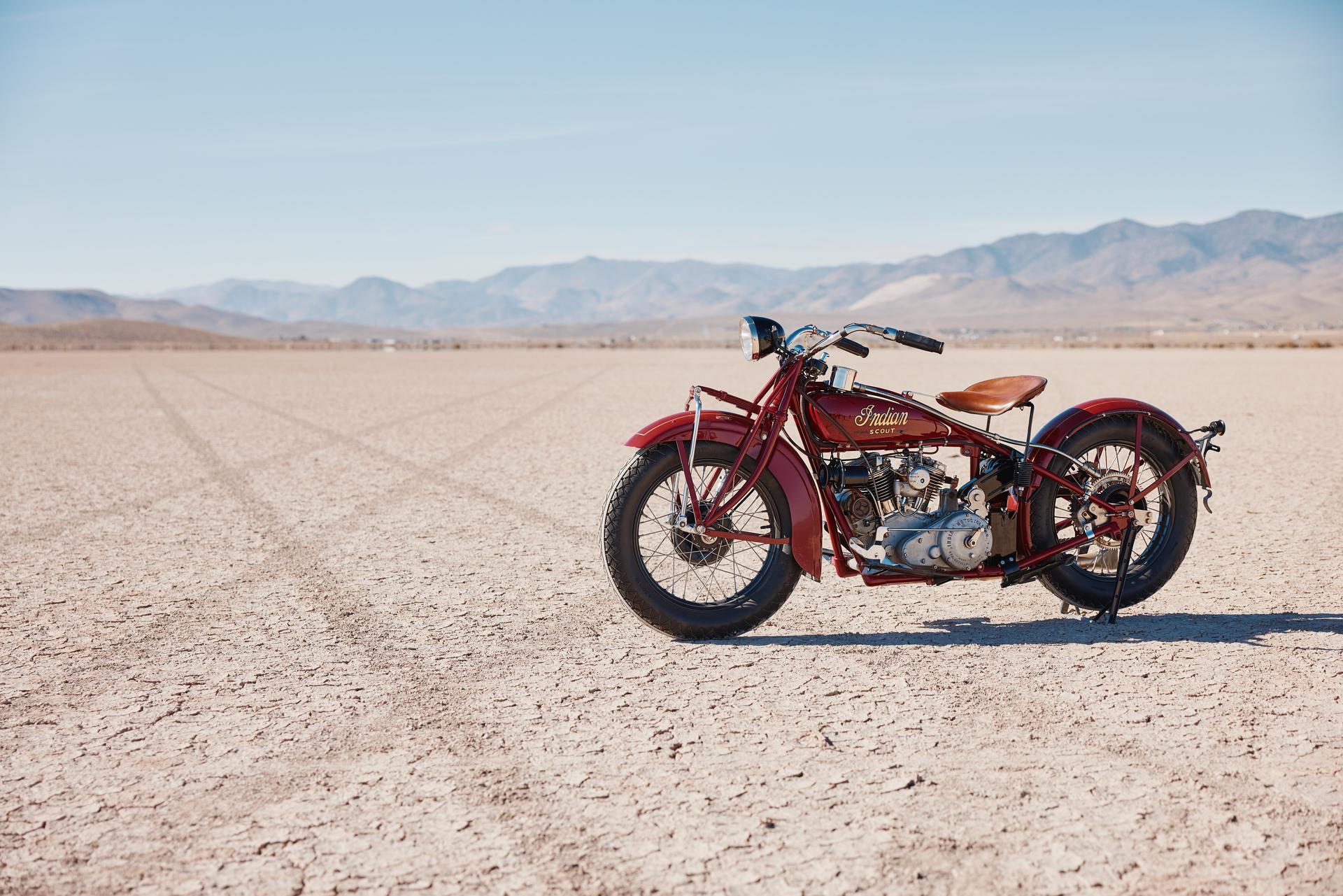
My lack of sleep goes back to another machine of the american brand, a friend’s 1928 Indian Scout 101 that we have been working on these last days (Bernhard Elflein, Herzbube Motorcycles, Revival of the machine: Herzbube’s Indian Scout 101 | Bike EXIF). He’s had the 101 for ages, one of those perfect, hard to finish projects. We spent long hours giving the old Scout its life back, the perfect anticipation to seeing the new icon, almost a century after its forefather was first brought to life. Midnight wrenching proves to be a great metaphor to describe the character one could associate to Indian: a restless, driven, maverick attitude. And I’m about to find out what has been made out of it.
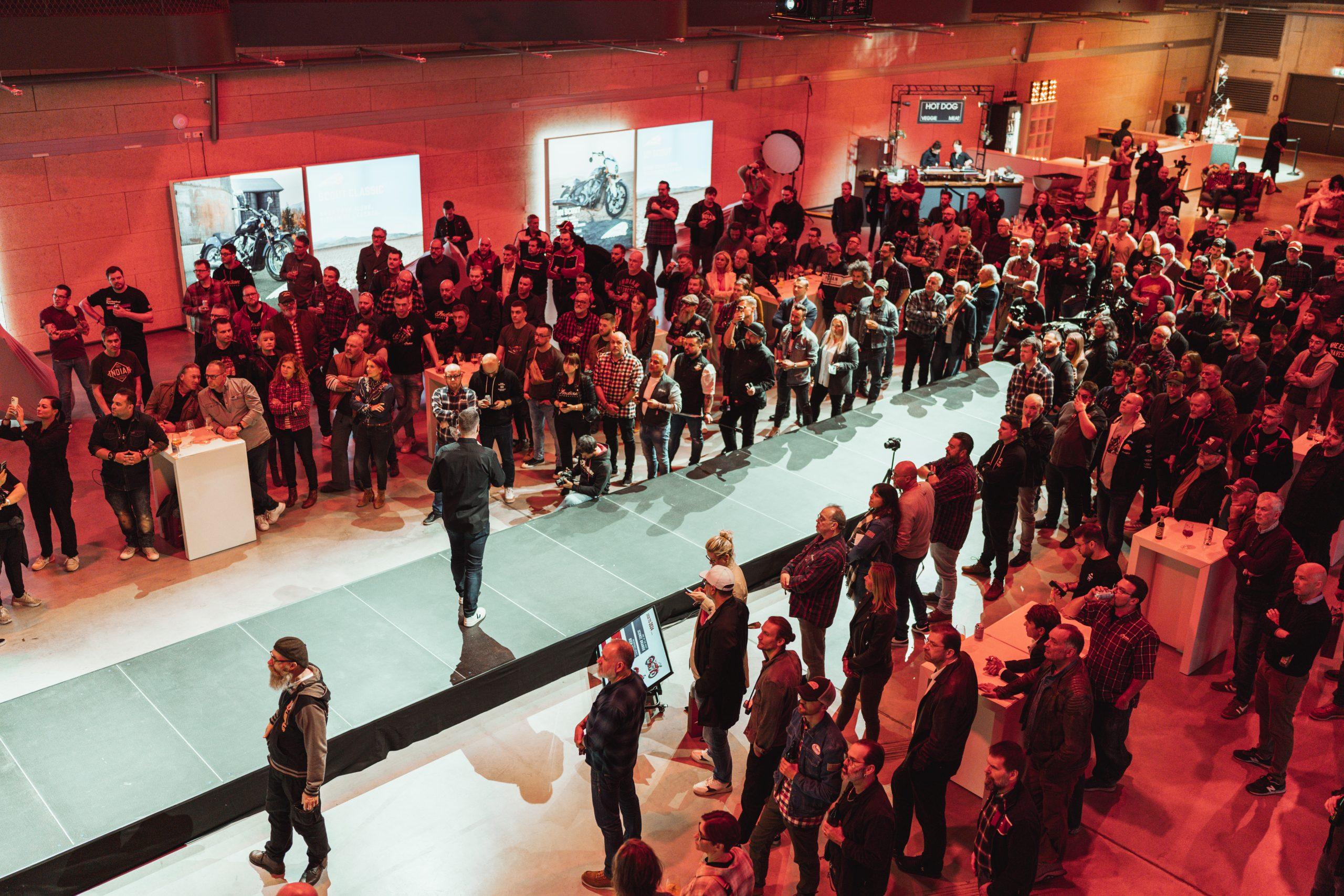
Photo: Olivier Groot
Meeting other attendants upon my arrival already gives a small preview of what could be expected: actors, racers… a wide array of backgrounds with a motorcycle brand as the touching point. Unusual, considering the homogeneity that brands tend to breed. But nothing about this reveal seems to be usual in any way. The chosen place for the occasion: Motorworld Munich, the automotive mecca of the German city, a huge event location packed with the rarest, most impressive machines of recent history.
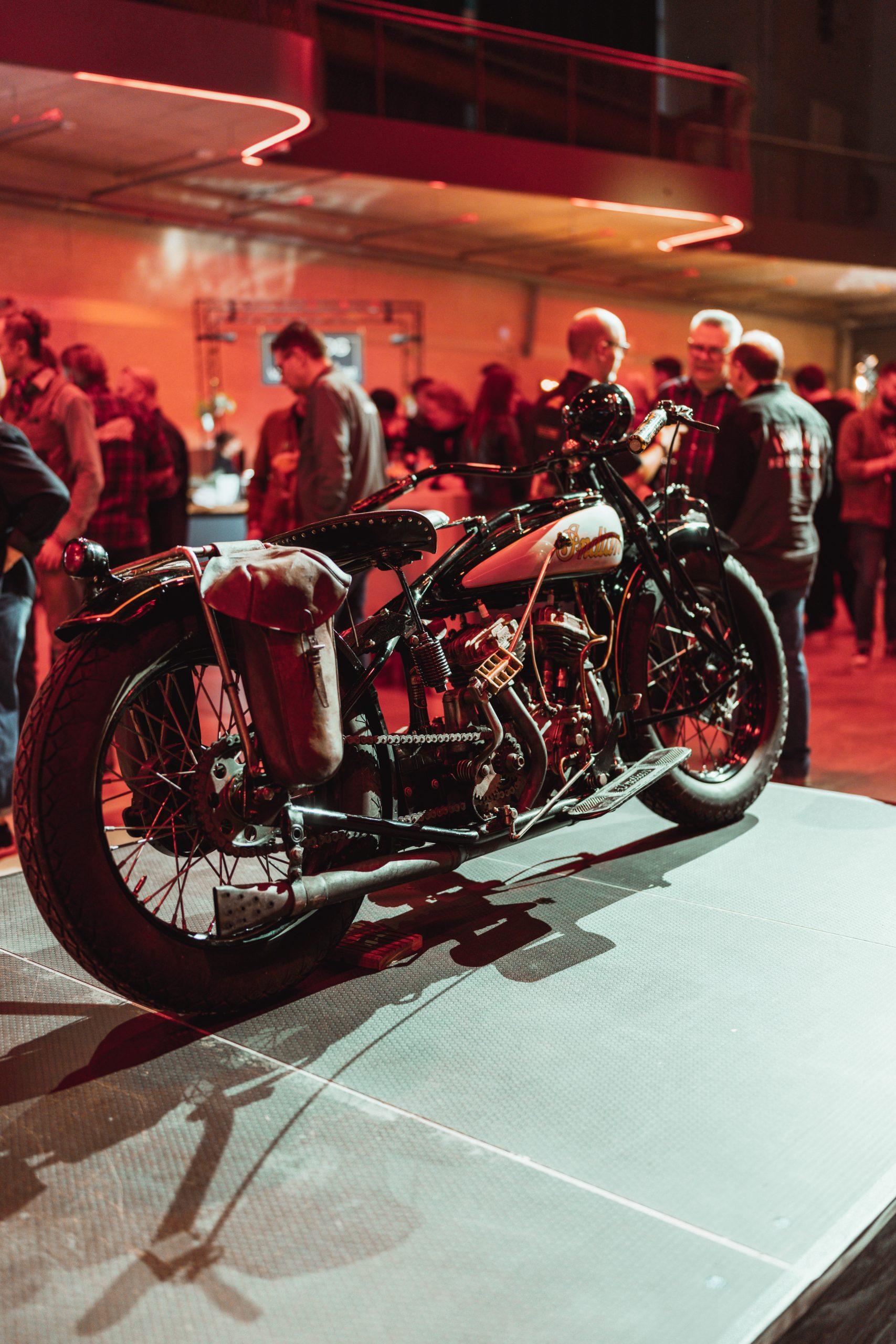
Photo: Olivier Groot
Soon after entering the room where the reveal will take place, we notice the covered silhouettes of the bikes we are here to see, parked on the side. Standing in the center, another beauty of early Indian years, this time courtesy of the Indian Motocycle Club Germany. You read that right, Motocycle, without the r, as read on original bikes. Indian people have been riding their lane since the very beginning, when attempts to register the full name led to dodge regulations by letting a letter out of the equation. Clever gentlemen. Christoph – caretaker of the old machine above – also had plenty of other stories to share. It seems like you might meet the nicest people on a Honda, but those with the greatest stories ride an Indian.

Photo: Olivier Groot
After warming up the atmosphere, those responsible for the launch take the stand to introduce the brand and the man leading its renewal, Ola Stenegärd, who guides the public through the creation of the latest machine, in a way very appreciated by anyone with a background in design or motorcycle building. In Ola’s words, the team focused on timeless aesthetics, concentrating on making stuff lean and clean while always keeping customizing in mind. The inspiration? The hot rod scene with legendary cars like Zephyrs, and the unmistakable lines of the original Indians. The design of the new Scout was considered through every layer, giving attention one can notice in every read: from afar, closer or in the smallest details, in the words of the designers.

Photo: Olivier Groot
All the anticipation leads to the covers being finally removed, revealing five models based on the new Scout: the Scout Classic, Scout Bobber, Sport Scout, Super Scout, and 101 Scout (a homage to the original 101, called the best motorcycle Indian ever made). All five share the same tubular frame design that has cleaned the overly heavy, casted feel of the previous model, a design that favors a connection to the vintage Scout and the current Chief. It now features a smaller radiator between the downtubes, neatly integrated rear shocks and that classic Indian downtube line. Features like shock travel, fenders, seats and wheels vary across the line, just like the final trim the customer can choose.

The new engine – called the Speedplus – has been completely redesigned, bored out to 1.250 cc and now pulls between 105 and 111 horsepower at 7.250 rpm, with 108 Nm of torque at a slightly lower 6.300 rpm. Many will miss the machined engine covers that contributed to the industrial look of the first modern Scout, but there is a general smoothness the bike has in its lines, angles and details that feels coherent and thought through. A very clean look altogether. Of course, it’s not the 1930’s anymore and no manufacturer will offer an exhaust system that doesn’t look like it belongs as a fuel tank in a multiplanetary rocket, but considering everything, the job done is more than acceptable.

Making a bike look like those built 90 years ago only goes so far, and so does losing oneself in poisonous terms like heritage. Throwing some chrome on everything won’t make anything better, neither will doing as if not a single decade has passed, and I think Indian have managed to create a modern machine that knows where it belongs, while not forgetting where it comes from. They put their hands in the fire and cast one hell of a piece out of the heat. Judge for yourselves.
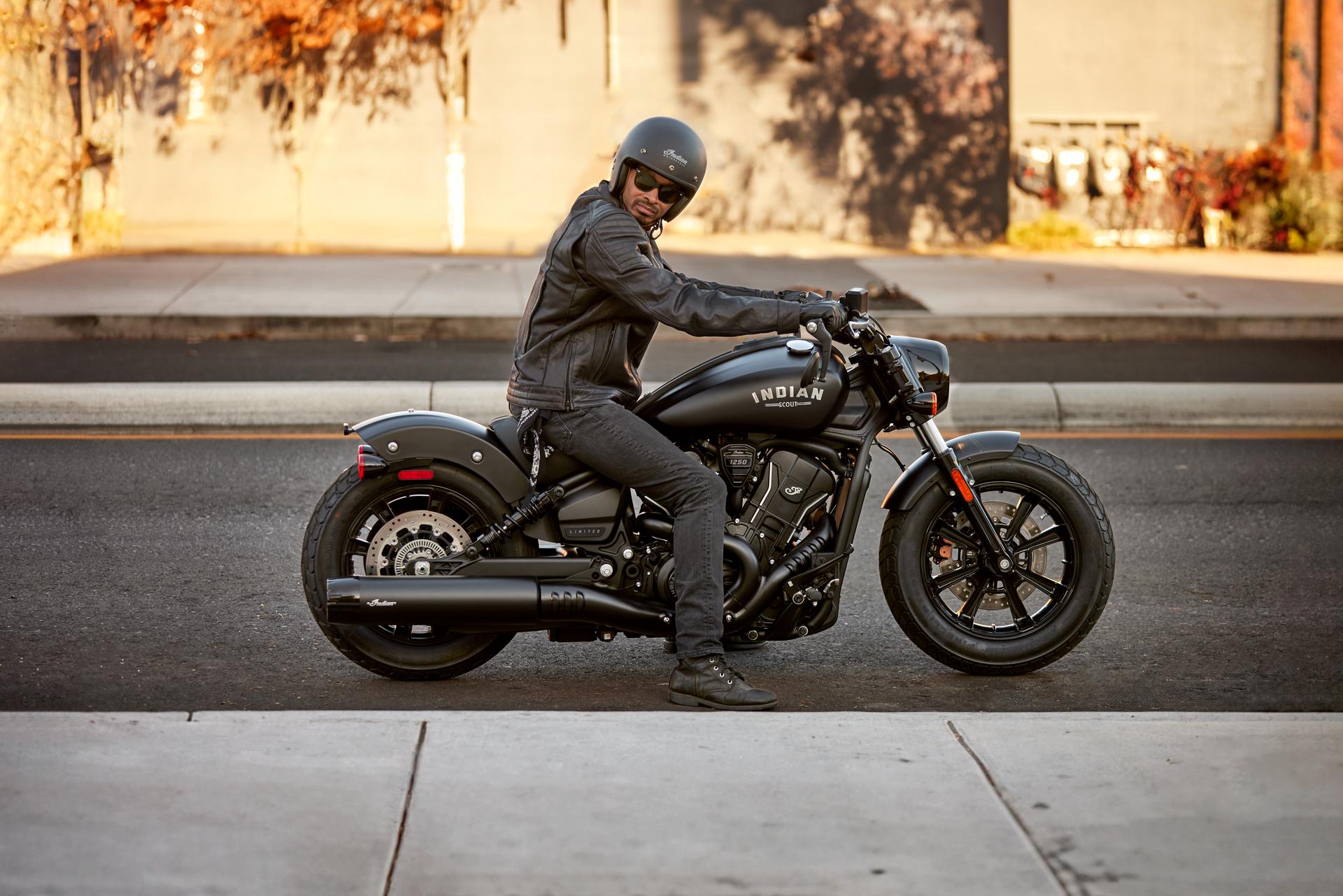
Check out our impressions of the new Indian Scout launch on YouTube!
Share This Story, Choose Your Platform!
Tags
Out of the silence, a screeching sound and a sudden wobble wake me up in an uninviting way – the train is reaching its next station. I’m on my way to Munich, where the all new Indian Scout will be revealed, the second iteration of the model that revived the long gone legend.

My lack of sleep goes back to another machine of the american brand, a friend’s 1928 Indian Scout 101 that we have been working on these last days (Bernhard Elflein, Herzbube Motorcycles, Revival of the machine: Herzbube’s Indian Scout 101 | Bike EXIF). He’s had the 101 for ages, one of those perfect, hard to finish projects. We spent long hours giving the old Scout its life back, the perfect anticipation to seeing the new icon, almost a century after its forefather was first brought to life. Midnight wrenching proves to be a great metaphor to describe the character one could associate to Indian: a restless, driven, maverick attitude. And I’m about to find out what has been made out of it.

Photo: Olivier Groot
Meeting other attendants upon my arrival already gives a small preview of what could be expected: actors, racers… a wide array of backgrounds with a motorcycle brand as the touching point. Unusual, considering the homogeneity that brands tend to breed. But nothing about this reveal seems to be usual in any way. The chosen place for the occasion: Motorworld Munich, the automotive mecca of the German city, a huge event location packed with the rarest, most impressive machines of recent history.

Photo: Olivier Groot
Soon after entering the room where the reveal will take place, we notice the covered silhouettes of the bikes we are here to see, parked on the side. Standing in the center, another beauty of early Indian years, this time courtesy of the Indian Motocycle Club Germany. You read that right, Motocycle, without the r, as read on original bikes. Indian people have been riding their lane since the very beginning, when attempts to register the full name led to dodge regulations by letting a letter out of the equation. Clever gentlemen. Christoph – caretaker of the old machine above – also had plenty of other stories to share. It seems like you might meet the nicest people on a Honda, but those with the greatest stories ride an Indian.

Photo: Olivier Groot
After warming up the atmosphere, those responsible for the launch take the stand to introduce the brand and the man leading its renewal, Ola Stenegärd, who guides the public through the creation of the latest machine, in a way very appreciated by anyone with a background in design or motorcycle building. In Ola’s words, the team focused on timeless aesthetics, concentrating on making stuff lean and clean while always keeping customizing in mind. The inspiration? The hot rod scene with legendary cars like Zephyrs, and the unmistakable lines of the original Indians. The design of the new Scout was considered through every layer, giving attention one can notice in every read: from afar, closer or in the smallest details, in the words of the designers.

Photo: Olivier Groot
All the anticipation leads to the covers being finally removed, revealing five models based on the new Scout: the Scout Classic, Scout Bobber, Sport Scout, Super Scout, and 101 Scout (a homage to the original 101, called the best motorcycle Indian ever made). All five share the same tubular frame design that has cleaned the overly heavy, casted feel of the previous model, a design that favors a connection to the vintage Scout and the current Chief. It now features a smaller radiator between the downtubes, neatly integrated rear shocks and that classic Indian downtube line. Features like shock travel, fenders, seats and wheels vary across the line, just like the final trim the customer can choose.

The new engine – called the Speedplus – has been completely redesigned, bored out to 1.250 cc and now pulls between 105 and 111 horsepower at 7.250 rpm, with 108 Nm of torque at a slightly lower 6.300 rpm. Many will miss the machined engine covers that contributed to the industrial look of the first modern Scout, but there is a general smoothness the bike has in its lines, angles and details that feels coherent and thought through. A very clean look altogether. Of course, it’s not the 1930’s anymore and no manufacturer will offer an exhaust system that doesn’t look like it belongs as a fuel tank in a multiplanetary rocket, but considering everything, the job done is more than acceptable.

Making a bike look like those built 90 years ago only goes so far, and so does losing oneself in poisonous terms like heritage. Throwing some chrome on everything won’t make anything better, neither will doing as if not a single decade has passed, and I think Indian have managed to create a modern machine that knows where it belongs, while not forgetting where it comes from. They put their hands in the fire and cast one hell of a piece out of the heat. Judge for yourselves.

Check out our impressions of the new Indian Scout launch on YouTube!
